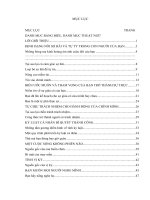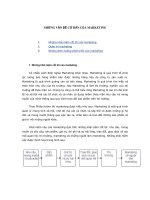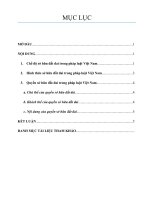PASSAGE 1
Bạn đang xem bản rút gọn của tài liệu. Xem và tải ngay bản đầy đủ của tài liệu tại đây (81.72 KB, 3 trang )
PASSAGE 1
Many of most flexible examples of tool use in animals come from primates (the group that includes
humans, apes, and monkeys). For example, many wild primates use objects to threaten outsides. But there
are many examples of tool use by other mammals, as well as by birds and other types of animals.
Tools are used by many species in the capture or preparation of food. Chimpanzees use sticks and poles to
bring out ants and termites from their hiding places. Among the most complex tool use observed in the
wild is the use of stones by Ivory Coast chimpanzees to crack nuts open. They select a large flat stone as
an anvil (a heavy block on which to place the nuts) and a smaller stone as a hammer. Stones suitable for
use as anvils are not easy to find, and often a chimpanzee may carry a haul nuts more than 40 meters to
finds a suitable anvil. The use of tools in chimpanzees is especially interesting because these animals
sometimes modify tools to make them better suited for their intended purpose. To make a twig more
effective for digging out termites, for example, a chimp may first strip it of its leaves.
Surprisingly, there is also a species of bird that uses sticks to probe holes in the search for insects. One of
the species of Galapagos finch, the wood pecker finch, picks up or breaks off a twig, cactus spine, or leaf
stem. This primitive tool is then help in the beak and used to probe for insects in holes in trees that the
bird cannot probe directly with its beak. Birds have been seen to carry twigs from tree to tree searching
for prey.
Tools may also be used for defense. Hermit crabs grab sea anemones with their claws and use them as
weapons to repel their enemies. Studies have demonstrated that these crabs significantly improve their
chances against predators such as octopus by means of this tactic. Also, many species of forest-dwelling
primates defend themselves by throwing objects, including stones, at intruders.
Question 1. What does the passage mainly discuss?
A. Primates are superior to other animals in using tools.
B. The use of stones as tools is similar across different animal species.
C. Birds and primates use tools that are different from those of sea animals
D. Many animals have developed effective ways of using tools.
Question 2. Why does the author mention ants and termites in the second paragraph?
A. To give an example of food that chimpanzee collect by using tools.
B. To emphasize that ants and termites often hide together in the same place.
C. To identify an important part of the chimpanzees diet.
D. To point out a difference between two closely related species.
Question 3. According to the passage Ivory Coast chimpanzees are among the most remarkable of animal
tool users because they______.
A. use tools to gather food
B. use more than one tool to accomplish a task
C. transport tools from one place to another
D. hide their tools from one other animals
Question 4. The word “haul” in the second paragraph is closest in meaning to______.
A. diet
B. type
C. load
D. branch
Question 5. The word “strip” in the second paragraph is closest in meaning to______.
A. search
B. eat
C. carry
D. remove
Question 6. The word “probe” in the third paragraph is closest in meaning to______.
A. change
B. watch
C. explore
D. create
Page 1
Question 7. According to the passage, what is characteristic of the way in which woodpecker finches
hunt insects?
A. The finches use different plant parts as tools to capture insects.
B. The finches make narrow holes in trees to trap insects.
C. The finches pick up insects that they find on leaves.
D. The finches catch insects in the air as they fly from tree to tree.
Question 8. Which of the following can be inferred from the passage about the behavior of the
woodpecker finch?
A. It uses its beak as a weapon against enemies.
B. It uses the same twig to look for food in different trees.
C. It uses twigs and leaves to build its nest.
D. It avoids areas where cactus grows.
Question 9. According to the passage, studies have shown that hermit crabs manage to turn octopus away
by ____________.
A. attacking the octopus with their claws
B. using stones as weapons
C. defending themselves with sea anemones
D. hiding under sea plants
Question 10. Forest primates and certain sea animals are mentioned in the passage as examples of
animals that use tools for_______.
A. self-protection
B. food preparation
C. hunting prey
D. building nests or home plants grow
ĐÁP ÁN
1-D
2-A
3-B
4-D
5-D
6-C
7-A
8-B
9-C
10-B
LỜI GIẢI CHI TIẾT
Question 1:
Many animals have developed effective ways of using tools = nhiều loài động vật đã phát triển các cách
sử dụng công cụ hiệu quả
Question 2:
to give an example of food that chimpanzee collect by using tools
Thông tin ở đoạn sau: “Tools are used by many species in the capture or preparation of food.
Chimpanzees use sticks and poles to bring out ants and termites from their hiding places.” (Các cơng cụ
được sử dụng bởi nhiều lồi trong việc lấy và chuẩn bị thức ăn. Tinh tinh sử dụng que và cọc để lấy kiến
và mối từ chỗ ẩn nấp của chúng.)
Question 3:
use tools to gather food
Thông tin ở đoạn sau: “Among the most complex tool use observed in the wild is the use of stones by
Ivory Coast chimpanzees to crack nuts open. They select a large flat stone as an anvil (a heavy block on
which to place the nuts) and a smaller stone as a hammer.” (Trong số cách sử dụng công cụ tinh vi nhất
Page 2
quan sát được trong hoang dã là việc dùng đá của tinh tinh ở bờ biển Ivory để tách quả hạch. Chúng chọn
viên đá phẳng lớn làm cái đe.)
Question 7:
Theo như đoạn trích, điều gì là đặc trưng cho cách mà chim sẻ đục gỗ săn côn trùng?
Đáp án A. Chim sẻ dùng nhiều phần khác nhau của cây cối làm công cụ bắt côn trùng.
Thông tin trong bài “…cũng có một lồi chim dùng que để dị lỗ tìm mồi cơn trùng. Một trong những lồi
chim sẻ đảo Galapagos, loài chim sẻ đục gỗ, chúng nhặt nhạnh hoặc bẻ lấy một cành cây, gai xương rồng
hoặc cuống lá…”
Các đáp án khác:
B, Chim sẻ đục các lỗ hẹp ở trên cây để bẫy côn trùng.
C, Chim sẻ bắt các côn trùng mà chúng tìm thấy trên lá cây.
D, Chim sẻ bắt các côn trùng lơ lửng trên không khi chúng bay từ cây này sang cây khác.
Question 8:
It uses the same twig to look for food in different trees
Thông tin ở đoạn sau: “Surprisingly, there … tree searching for prey.” (Đáng ngạc nhiên là, có cả lồi
chim dùng que để bới các hố tìm kiếm cơn trùng. Một trong những loài chim sẻ Galapagos, chim gõ kiến
nhặt nhạnh hoặc cắt đứt cành con, gai xương rồng hoặc cọng lá.Công cụ thơ sơ này về sau có tác dụng
như chiếc mỏ và được sử dụng để gỡ các con côn trùng ở trong các lỗ trong cây mà con chim không thể
gỡ ra trực tiếp bằng mỏ của mình được. Các con chim mang các cành từ cây này sang cây khác để tìm
mồi.)
Question 9:
defending themselves with sea anemones
Thơng tin ở đoạn sau: “Hermit crabs grab sea anemones with their claws and use them as weapons to
repel their enemies. Studies have demonstrated that these crabs significantly improve their chances
against predators such as octopus by means of this tactic.” (Các con cua ẩn dật bám lấy cỏ chân ngỗng
biển bằng các càng của chúng và sử dụng chúng như vũ khí để xua đuổi kẻ thù của mình. Các nghiên cứu
đã chứng minh rằng những con cua này cải thiện 1 cách đáng kể cơ hội chống lại các loài ăn thịt như bạch
tuộc bằng phương thức này.)
Question 10:
food preparation
Thông tin ở đoạn sau: “Tools are used by many species in the capture or preparation of food.” (Các cơng
cụ được nhiều lồi sử dụng trong việc lấy và chuẩn bị thức ăn.)
Page 3



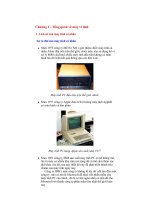
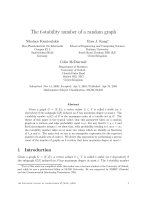
![Moi gioi BAT DONG SAN 01[1].ppt](https://media.store123doc.com/images/document/12/gu/pr/medium_VqscYiF6ld.jpg)
